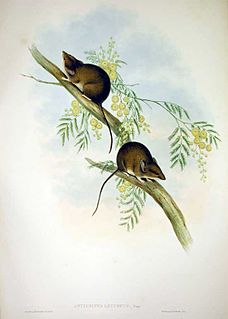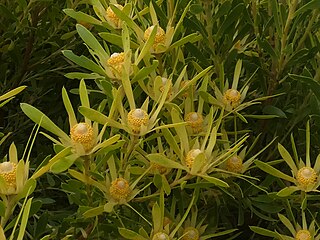Related Research Articles

The stoat or short-tailed weasel, also known as the Eurasian ermine, Beringian ermine, or simply just ermine, is a mustelid native to Eurasia and the northern portions of North America. Because of its wide circumpolar distribution, it is listed as Least Concern on the IUCN Red List.

Sexual dimorphism is the condition where the sexes of the same species exhibit different characteristics, particularly characteristics not directly involved in reproduction. The condition occurs in most animals and some plants. Differences may include secondary sex characteristics, size, weight, colour, markings, or behavioural or cognitive traits. These differences may be subtle or exaggerated and may be subjected to sexual selection and natural selection. The opposite of dimorphism is monomorphism, which is when both biological sexes are phenotypically indistinguishable from each other.

Atypidae, also known as atypical tarantulas or purseweb spiders, is a spider family containing only three genera. They are accomplished ambush predators that spend most of their time in a sock-like, silken retreat on the ground from where they kill their prey.

The white-footed dunnart is a marsupial that occurs on Tasmania and mainland Australia. It occurs along the coast and in inner Gippsland and Alpine areas up to 400 metres near Narbethong. In southern New South Wales, the white-footed dunnart is known to occur at elevations at least as high as 1000 metres. The length from snout to tail tip is 140–200 mm of which head to anus is 70–110 mm and tail 70–90 mm long and with a weight of 19–27 g.

The Little long-tailed dunnart(Sminthopsis dolichura) is a dunnart that was, along with Gilbert's dunnart, described in 1984. The length from snout to tail is 150–200 mm of which head to anus is 65–50 mm and tail 85–105 mm long. Hind foot size is 16–17 mm, ear length of 17–19 mm and with a weight of 10-20 g.

The smallest organisms found on Earth can be determined according to various aspects of organism size, including volume, mass, height, length, or genome size.

The California vole is a type of vole which lives throughout much of California and part of southwestern Oregon. It is also known as the "California meadow mouse", a misnomer as this species is a vole, not a mouse. It averages 172 mm (6.8 in) in length although this length varies greatly between subspecies.
The inland forest bat is a vespertilionid bat that occurs in central and arid regions in Australia. They were first described in 1987, published in a review of poorly surveyed microbat populations. A tiny flying mammal, whose body is around twelve millimetres (½ inch) long, that occupies small cavities in trees and buildings while roosting. The nocturnal activity is foraging for insects, typically moths.

The red fruit bat or red fig-eating bat is a species of bat in the family Phyllostomidae, in the monotypic genus Stenoderma. It is found in Puerto Rico and the U.S. Virgin Islands.

Hakea epiglottis is a shrub commonly known as beaked hakea or needlebush hakea and is endemic to Tasmania where populations consist of functional unisexual plants. In a 1989 publication by John Wrigley & Murray Fagg states specimens at Wakehurst Place, an annexe of Kew Gardens London are specimens believed to be 60-70 years old measuring 3 m (9.8 ft) high and wide.

Moniliformidae is a family of parasitic spiny-headed worms. It is the only family in the Moniliformida order and contains three genera: Australiformis containing a single species, Moniliformis containing eighteen species and Promoniliformis containing a single species. Genetic analysis have determined that the clade is monophyletic despite being distributed globally. These worms primarily parasitize mammals, including humans in the case of Moniliformis moniliformis, and occasionally birds by attaching themselves into the intestinal wall using their hook-covered proboscis. The intermediate hosts are mostly cockroaches. The distinguishing features of this order among archiacanthocephalans is the presence of a cylindrical proboscis with long rows of hooks with posteriorly directed roots and proboscis retractor muscles that pierce both the posterior and ventral end or just posterior end of the receptacle. Infestation with Monoliformida species can cause moniliformiasis, an intestinal condition characterized as causing lesions, intestinal distension, perforated ulcers, enteritis, gastritis, crypt hypertrophy, goblet cell hyperplasia, and blockages.

Leucadendron salignum, also known as the common sunshine conebush, is an evergreen, dioecious shrub that produces several stems from the ground of up to 2 metres high; forming part of the genus Leucadendron from the family Proteaceae. It survives the wildfires that occur every one or two decades in the fynbos where it occurs by regrowing from an underground rootstock. Pollinated by beetles, it flowers from April to November. The winged seeds remain in the woody cones until they are released after a fire, and are distributed by the wind. It is possibly the most common Proteaceae species in South Africa, and can be found in the Northern Cape, Western Cape and Eastern Cape provinces. Its current conservation status is Least Concern.

Leucadendron coniferum, also known at the dune conebush, is an evergreen, dioecious shrub or small tree of up to 4 m (13 ft) high, that has been assigned to the family Proteaceae. It has a whorl of conspicuous yellow leaves subtending the flowerheads. The flowers can be found in August and September. It grows in sandy soils near the coast of the Western Cape province of South Africa.
Habroteleia is a genus of parasitic wasps in the family Platygastridae. There are about 9 described species in Habroteleia.

Habroteleia flavipes, is a species of wasp belonging to the family Platygastridae.
Habroteleia mutabilis, is a species of wasp belonging to the family Platygastridae. It is described from Fiji.
Habroteleia ruficoxa, is a species of wasp belonging to the family Platygastridae. It is found in Philippines.
Habroteleia salebra, is a species of wasp belonging to the family Platygastridae. It is described from Papua New Guinea and Indonesia.
Habroteleia soa, is a species of wasp belonging to the family Platygastridae. It is the most geographically disjunct member of the genus, which is separated by other members by the Indian Ocean. It is found in Papua New Guinea and Indonesia.
Habroteleia spinosa, is a species of wasp belonging to the family Platygastridae. It is described from Papua New Guinea and Indonesia.
References
- 1 2 Chen, H. Y.; Talamas, E. J.; Masner, L.; Johnson, N. F. (17 January 2018). "Revision of the world species of the genus Habroteleia Kieffer". ZooKeys (730): 87–122. doi: 10.3897/zookeys.730.21846 . PMC 5799745 . PMID 29416398 . Retrieved 3 April 2018.